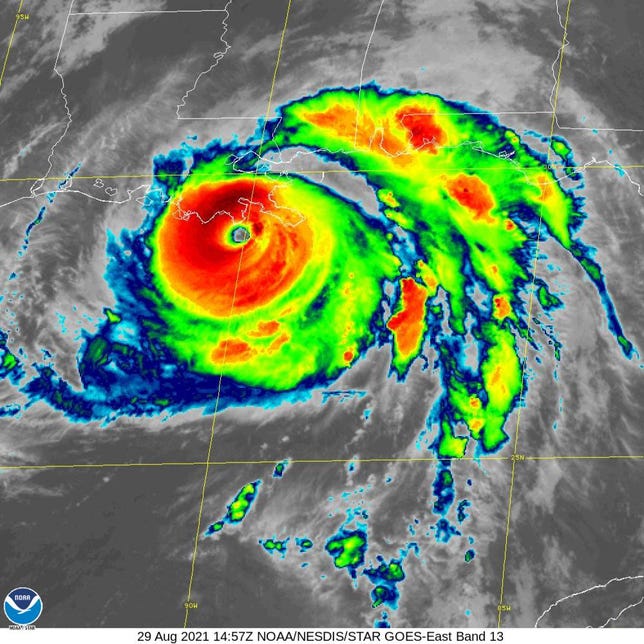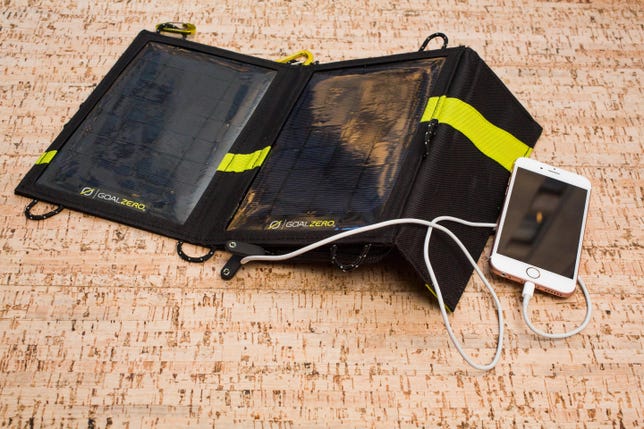Hurricane Ida took out power for half of Louisiana and shut down 911 service in New Orleans on Sunday after it hit the state as a Category 4 storm with 150 mph winds. On Monday, it continued to batter Louisiana and Mississippi as a tropical storm.
Ida has devastated the area, flooding roads and blowing off roofs, with one man reported dead after a tree hit his home. Ida landed exactly 16 years to the day since Hurricane Katrina crashed ashore. Time was not on the side of many residents, as this storm strengthened rapidly, jumping from a Category 1 to a strong Category 4 in less than 24 hours.
With more than 1 million customers lacking power, utility companies predict power could be out for as long as three weeks. Experts are still analyzing the damage and what it takes to restore power. Getting by without power for three hours is one thing; getting by for three days or longer requires a survivalist's strategy.

Hurricane Ida became a Category 4 hurricane with 150-mph sustained winds. The storm was a deadly threat as it approached the Louisiana coast Sunday.
NOAAIn today's smartphone-dependent world, those in the path of a storm can't count on apps to be a sole source for all news and communication with the outside. A hurricane can leave many stranded without power for days on end in a dark home with nothing but a dead phone battery.
I grew up in South Florida, where planning to go a week without power is part of the norm for summer hurricane season. I'll never forget my family huddled around the radio and battery-powered TV for information after the monster Category 5 Hurricane Andrew leveled entire neighborhoods nearby in 1992. I now keep my family prepared with backup power supplies and go-bags packed with basics, in case there's a need to evacuate.
There's no app for this
Sure, stocking up on enough water and canned food to last a week is important, but it's just as vital to think how you'll power the essential tech, including your phone, lights at night, and even a small energy-efficient radio or LED TV for news (that is, as long as you have an antenna to pick up over-the-air broadcast signals). In an emergency, you can't rely on your phone for news.
For some firsthand perspective, I went to survivalists, including Lt. Col. Scott Mann, a retired Green Beret who served in conflict zones and now trains corporate execs on how to tough it out in the wild. Mann stresses the importance of owning a variety of backup power sources.
Before turning to a battery, explains Mann, you'll need to change your phone habits. No playing games and no scrolling through Facebook (except for getting news on the safety of loved ones, of course). Your phone is now a survival tool. Turn it off to conserve power unless you need to reach someone.
Satellite imagery of Hurricane Ida before it hit the Louisiana coast Sunday morning.
NOAAKeep in mind that even if you have power, checking in with mom may be impossible, at least for a while. Cell towers, if operating, aren't designed to handle everyone in a given area trying to use their phone at once. Hurricane specialist Bryan Norcross has seen this firsthand during monster storms. During Hurricane Andrew, he was the voice my family counted on through his broadcasts over the radio. Now he shares his storm warnings with the world through his Facebook and Twitter posts. He sees the potential complications with our phone dependence.
"It's very scary that there's a significant part of the populace that doesn't have a way to get information if cellphones don't work," Norcross says. "That's the biggest public safety problem we have."
He advises that if there's network congestion, send a text message instead of calling. Not only does it take up fewer network resources, but even if the text gets stuck in a network traffic jam it should eventually get through.
Juice up
An outage can last a day or a week, so you'll need a few options for backup battery packs. They come in many sizes and capacities, depending on how much you're willing to spend. A power bank -- like those made by Anker -- is good for travel, but you also can buy larger battery packs that could power even your TV for short intervals. There's the Duracell Powerpack Pro and Black & Decker Power Station, which are also sold to jump-start car batteries. On the pricier side are ones like the Jackery Portable Power Station, which can handle the TV, fan and a few phones.
Once you buy them, though, don't let batteries sit in your closet for a year and expect them to work when disaster strikes. Batteries degrade over time, and leaving one idle is a sure way to kill it. As a rule of thumb, follow the manufacturer's guidance, keep it charged up, use it every so often, and store it in a cool room to preserve it longer.
Don't forget: The car can give your gadgets an emergency charge, too. And be sure to keep enough gas in the tank to drive away if you need to evacuate quickly.

Goal Zero makes a variety of solar chargers.
Sarah Tew/CNETSolar support
Camping stores are a great resource for good portable solar battery chargers. But think of solar chargers as the backup to your backup. It can take a long time to harness enough energy just for one phone -- sometimes at least five hours of direct sunlight.
When buying a solar charger, know that the larger the panel, the more successful the charge. And since not all solar chargers will store the energy for extended periods, you should transfer collected juice to another battery pack. Plan to spend between $50 to $100 to get a decent one -- the better models are made by Goal Zero and RAVPower -- and always look for products with a manufacturer's warranty.
Give it some gas
If you're planning on buying a gas-powered generator, you'll want a UPS pack, which is short for uninterrupted power supply. Gas-powered generators can put out "dirty" power, meaning the voltage fluctuates and can damage electronics. Using a UPS to filter the power can prevent your tech from frying, Norcross says.
Some generator models, like the Honda EU2200 series, come with a built-in inverter to pump out more stable power for your computers. George Hill, an ex-soldier and expert survivalist who has been through his share of storms, says Honda's models are small enough to store under a bed and can run about eight hours on one gallon of gas (depending on the load). At around $1,000, it's a hefty investment, but it could make a big difference when power is out for the long haul. And although this may seem obvious, never run a gas-powered generator indoors, no matter how desperate you are for power. The carbon monoxide will kill you.
Food, water and shelter are all important parts of the storm survival plan. But here's a checklist of the gear you'll need to stay powered during an extended outage:
- Battery-powered lantern and headlamps (and plenty of extra batteries).
- Need to evacuate and you won't have a car? Make sure you have a handheld GPS that runs off AA batteries.
- Hikers use a Spot personal-tracking GPS to let loved ones know their place on a map, and can get help with the press of a button. This is also handy for when you can't use a phone to let people know if you need emergency assistance, or to send a blast message to family that you are OK.
- Get a heavy-duty, extra-long extension cord (200+ feet). If the neighbor has power before you, they may lend you an outlet.
- Don't just rely on wimpy phone backup batteries. Get a heavy-duty portable power pack, which costs around $200 to $300. They can even jump-start a car.
- A gas-powered generator and UPS to filter the power are handy for keeping you sane in the long-haul. Just learn how to use it before disaster strikes -- and don't use it indoors.
- Solar power can be a savior when all other batteries are depleted and you can't leave your home. Don't just go for the cheapest thing on Amazon. The larger the panel to soak up rays, the better. Get one with a warranty to ensure quality.
- Don't count on hand-cranking if you can help it. Get a portable battery-powered radio to stay on top of news.
- Can you watch TV news without cable? If you live in a metro area, you should be able to pick up broadcast signals with a digital TV antenna. Use it with a low-energy LCD TV so you don't lose all your battery juice at once.
https://ift.tt/3jpSgHE


Tidak ada komentar:
Posting Komentar